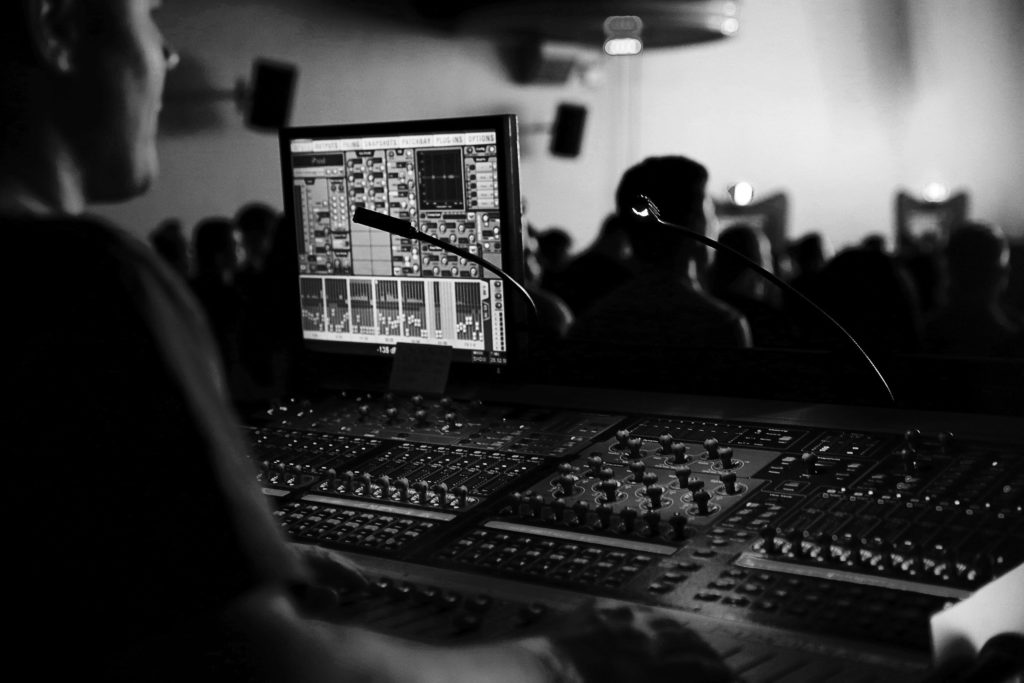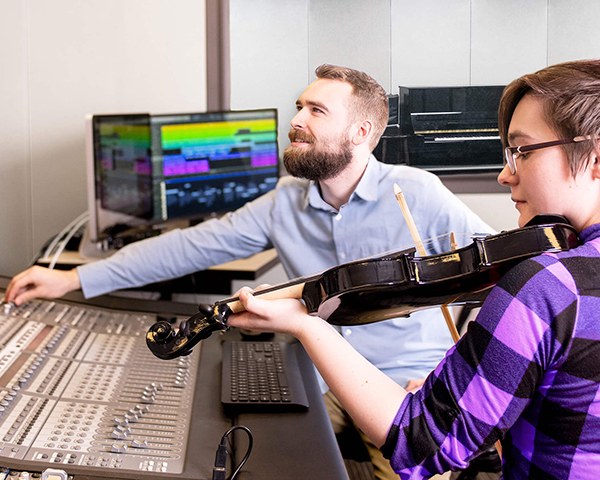An audio mixing engineer is responsible for blending and adjusting the various elements of recorded sound to create a polished final audio product. They ensure that the levels, frequencies, and effects are balanced to achieve a cohesive and professional-sounding mix.
Audio mixing engineers work with artists and producers to bring their vision to life and enhance the overall listening experience. In today’s dynamic music industry, the role of an audio mixing engineer is more essential than ever. With advancements in technology and the increasing demand for high-quality audio content, skilled professionals in this field are in high demand.
Whether working on music albums, podcasts, films, or live events, audio mixing engineers play a critical role in delivering top-notch sound that captivates audiences around the world. Their expertise and attention to detail elevate the overall quality of any audio production, making them indispensable members of any creative team.

Credit: musicproductionglossary.com
The Role Of An Audio Mixing Engineer
An audio mixing engineer plays a pivotal role in the music and sound production industry, responsible for enhancing the quality of audio recordings by adjusting levels, frequencies, and effects.
Setting The Mood With Sound
Audio mixing engineers use various tools and techniques to create a cohesive sound mix that sets the mood and enhances the overall listening experience.
Balancing Levels And Frequencies
They carefully balance the levels of different audio elements and frequencies to ensure a harmonious blend and prevent any part from overpowering the others.
Skills And Tools For The Job
An audio mixing engineer needs to have a solid grasp of acoustics and sound theory to create balanced soundscapes.
They must be skilled in using audio editing software to manipulate sound elements effectively.
Collaboration And Communication
Collaboration and communication are essential aspects of an audio mixing engineer’s job. Working closely with producers, artists, and other team members, an audio mixing engineer must effectively communicate creative vision and collaborate to bring the desired sound to life.
Working With Producers And Artists
Audio mixing engineers collaborate with producers and artists to understand their musical vision and ensure that the final mix reflects the intended emotions and atmosphere of the song. This involves open communication, active listening, and the ability to translate verbal descriptions into a cohesive audio mix. Effective collaboration with producers and artists is crucial for achieving a successful final product that meets everyone’s expectations.
Communicating Creative Vision
One of the key responsibilities of an audio mixing engineer is to effectively communicate their creative vision for the mix to the producers and artists. This involves the ability to express technical concepts in layman’s terms, present creative ideas, and integrate feedback into the mix while maintaining the overall vision. Clear and concise communication is vital for aligning everyone’s expectations and ensuring a harmonious creative process.
Challenges And Techniques
An audio mixing engineer’s job involves combining and balancing different sound elements to create a cohesive and engaging audio experience. This requires a deep understanding of audio equipment, technical proficiency, and creative problem-solving skills. Challenges can arise from conflicting sound elements, technical limitations, and client preferences, requiring the use of various techniques like EQ adjustments, compression, and spatial processing to achieve the desired audio mix.
Managing Complex Audio Tracks
Managing complex audio tracks is one of the main challenges faced by audio mixing engineers. With multiple instruments, vocals, and other audio elements, it can become overwhelming to ensure each element is properly balanced and audible. To tackle this challenge effectively, audio mixing engineers employ various techniques and tools to organize and manipulate the audio tracks.
Techniques:
- Organization: Audio mixing engineers start by organizing the different audio tracks, arranging them in a logical manner to facilitate easy access and editing.
- Level balancing: Adjusting the volume levels of each track is crucial to achieve a harmonious and well-balanced mix. By carefully adjusting the levels, the mixing engineer ensures that no individual element overpowers the others.
- Panning: By panning the audio tracks, the engineer creates a sense of space and stereo width. This allows different instruments to occupy different positions in the stereo field, resulting in a more immersive listening experience.
- EQ (Equalization): Applying EQ helps in enhancing the tonal characteristics of individual tracks, eliminating unwanted frequencies, and ensuring clarity in the mix. This technique enables each element to occupy its own sonic space.
- Compression: Compression is applied to control the dynamic range of the audio tracks. It helps in reducing the difference between the loudest and softest parts, resulting in a more consistent and polished sound.
Applying Creative Effects
Another important aspect of an audio mixing engineer’s job is applying creative effects to enhance the overall sonic experience. This involves using various audio plugins and processors to add depth, texture, and character to the mix.
Techniques:
- Reverberation: Reverberation adds a sense of space and natural ambience to the audio tracks. By manipulating the parameters of reverberation plugins, mixing engineers can simulate different acoustic environments.
- Delay: Delay effects create echoes and reflections, adding depth and dimension to the audio mix. With precise timing and feedback settings, the engineer can achieve various creative delays ranging from subtle to pronounced.
- Modulation: Modulation effects like chorus, flanger, and phaser can transform the audio tracks by introducing movement, vibrato, and swirling textures. These effects create interest and uniqueness in the overall sound.
- Distortion: Distortion plugins are used to add grit, aggression, or warmth to individual tracks or the entire mix. This technique is particularly useful in genres like rock and metal where a raw and edgy sound is desired.
- Automation: Automation allows the mixing engineer to dynamically adjust various parameters over time. It enables precise control over volume, panning, EQ, and other effects, adding dynamics and emotion to the mix.
In conclusion, managing complex audio tracks and applying creative effects are two significant challenges faced by audio mixing engineers. By using various techniques and tools, these professionals strive to achieve cohesive, balanced, and engaging mixes that bring out the best in the music.
The Art Of Achieving A Harmonious Blend
An audio mixing engineer holds the unique ability to transform raw audio recordings into a polished masterpiece. They play a crucial role in the music production process, ensuring that all the elements of a song seamlessly come together to create a harmonious blend. Through various techniques, an audio mixing engineer crafts a distinct sound, creating seamless transitions that captivate the listener’s ear.
Creating Seamless Transitions
One of the primary responsibilities of an audio mixing engineer involves creating seamless transitions between different sections of a song. They skillfully blend together various elements, such as vocals, instruments, and effects, to ensure a smooth flow from one section to the next. By carefully adjusting levels, adding crossfades, and applying other creative techniques, they eliminate any abrupt or jarring transitions that could disrupt the listening experience.
Crafting A Distinct Sound
Another crucial aspect of the audio mixing engineer’s job is to craft a distinctive sound for the final mix. They use their expertise in equalization, compression, and other processing techniques to enhance the tonal balance and dynamics of each individual element in the mix. By carefully sculpting the frequencies and adding subtle effects, they bring out the character and uniqueness of each instrument and voice, ensuring that the overall sound stands out.
- Equalization: Precisely adjusting the frequency content of each track to achieve clarity and balance.
- Compression: Controlling the dynamic range of each track to maintain a consistent level and enhance the overall impact.
- Reverb and Delay: Adding spatial effects to create depth and ambiance, making each element feel like it exists in its own space.
The audio mixing engineer’s goal is not to simply make everything louder or clearer, but to use these tools creatively to shape the audio and bring out its full potential. Their meticulous attention to detail ensures that every instrument and voice has its place in the mix, resulting in a captivating sonic experience for the listener.
In conclusion, the job of an audio mixing engineer goes beyond technical expertise. It requires an artistic sensibility, a keen ear, and a deep understanding of the desired sonic aesthetic. By creating seamless transitions and crafting a distinct sound, they contribute immensely to the overall production quality and the emotional impact of the music.

Credit: www.digipen.edu

Credit: digico.biz
Frequently Asked Questions For What Is The Job Of Audio Mixing Engineer
What Does An Audio Mixing Engineer Do?
An audio mixing engineer is responsible for blending different audio tracks, adjusting volumes, and applying effects to create a balanced and polished sound. They ensure that all elements of a recording, such as vocals, instruments, and other sounds, harmoniously come together to create a cohesive final product.
How Does An Audio Mixing Engineer Contribute To The Music Production Process?
Audio mixing engineers play a crucial role in the music production process. They enhance the clarity, depth, and overall sound quality of a recording. By using their technical expertise, they bring out the best in each individual track and make sure all elements work seamlessly together, resulting in a professional and engaging final mix.
What Skills Does An Audio Mixing Engineer Need?
An audio mixing engineer needs a strong understanding of audio equipment, sound editing software, and signal flow. They should also possess a good ear for music, a sense of timing and rhythm, attention to detail, and the ability to communicate effectively with other professionals involved in the production process.
How Does The Audio Mixing Engineer Collaborate With Artists And Producers?
Audio mixing engineers work closely with artists and producers to ensure their creative vision is realized in the final mix. They carefully listen to the artist’s feedback, incorporate their preferences, and make adjustments accordingly. By understanding the artist’s intentions, they can optimize the audio mix to reflect the desired emotional and sonic qualities of the music.
Conclusion
The role of an audio mixing engineer is indispensable in the music industry. Their ability to blend and enhance audio elements is crucial for creating a high-quality sound. A skilled mixing engineer can bring out the best in a song, ensuring a polished and professional result.
With their expertise, they play a vital part in the success of any music production.